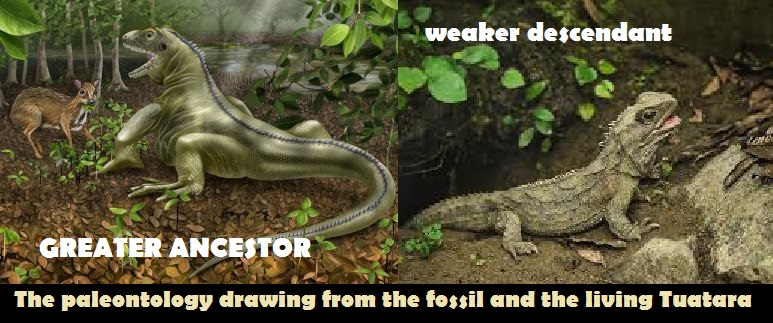“Lizard King”, tuatara
Tuatara and the Lizard King
‘Lizard King’ fossil shows giant reptiles coexisted with mammals
“the Lizard King,” a lizard roamed the hot tropical forests of Southeast Asia.
The giant lizard from Myanmar this week in the scientific journal Proceedings of the Royal Society B. Their analysis shows that it is one of the biggest known lizards ever to have lived on land.
Barbaturex morrisoni. it’s been named for the aforementioned Doors singer:
At almost six feet long
and weighing upwards of 60 pounds,
The lizard says much about genetic entropy, and nothing about climate or changes that may have or have not happened.
But B. morrisoni lived in an ecosystem with a diversity of both herbivorous and carnivorous mammals.
Size is not regulated through the organism by heat or cold on the genetic level. Hot or cold theories do not apply as both reptile and mammals lived together, both were larger at the same time and in the same environment. The environment does not observably effect the size of a creature genetically or long term, however there are slight changes in the phenotype (the organism as a whole) but they are very slight and are not permanent.
Oxygen and carbon dioxide does effect the organism in size as well, however the changes in size are not permanent, and affect the organism and not its offspring’s genetics.
Competition for food does not affect size, it is necessary that size changes must be attributed to the creature’s genetics, as immediate changes of the diet are known to affect a creature’s size, diet in any way affects the size of the offspring.
“We think the warm climate during that period of time allowed the evolution of a large body size and the ability of plant-eating lizards to successfully compete in mammal faunas,” Head said.
Large mammals and larger reptiles existed simultaneously, both were greater in size. Government academics fail in attributing warm climate as the mechanism for change in size in reptiles. First, no observation or testing to date demonstrates that heat changes reptiles on the genetic level. If heat did affect retiles (it doesn’t), and cold did affect mammals in size, then these two failed theories cancel each other out as large size is present in every organism in the past.
“Head worked with Patricia Holroyd of University of California at Berkeley, Gregg Gunnell of Duke University, and Russell Ciochon of the University of Iowa on identifying and analyzing B. morrisoni.”
Barbaturex morrisoni — “Morrison’s Bearded King” — It was larger than most of the mammals with which it lived.
Fossils of the giant lizard, which were originally found by Ciochon and colleagues in the 1970s in Myanmar, were unstudied in the University of California Museum of Paleontology until a few years ago, when Head and Holroyd began looking into them.
When Head first examined the fossils, he noticed the creature’s bones were characteristic of a group of modern lizards.
“It struck me that we had something here that was quite large, and quite unique,” said Head, an assistant professor of earth and atmospheric sciences at UNL and a curator in the University of Nebraska State Museum of Natural History’s Division of Vertebrate Paleontology.”
“I was listening to The Doors quite a bit during the research,” Head said. “Some of their musical imagery includes reptiles and ancient places, and Jim Morrison was of course The Lizard King, so it all kind of came together.”
The Earth is designed to be “self cleaning”, “self purifying” and mankind does little to nothing to affect the Earth in any long term fashion.
(Photo Credit: Angie Fox, Nebraska State Museum of Natural History, University of Nebraska-Lincoln)
Source: University of Nebraska-Lincoln osted By News On June 5, 2013 – 12:30am
(Photo Credit: Angie Fox, Nebraska State Museum of Natural History, University of Nebraska-Lincoln)


Comment